|
August
2012 |
||
![]()
![]() Selected
WW2 70th Anniversaries this month:
Selected
WW2 70th Anniversaries this month:
Between 2009 and 2015, I will be pursuing a general modelling theme that marks selected 70th Anniversaries from WW2.

2 August 1942. Convoy WS sails from the Clyde for Operation Pedestal.
7 Aug - US Forces begin their first offensive action of WW2 with Operation Watchtower, amphibious landings at Guadalcanal in the Solomon Islands.
|
10 August - Convoy WS transits the Straits of Gibraltar and joins the Pedestal naval force, the largest convoy escort force ever assembled. The next day, HMS EAGLE, one of 4 escorting carriers is sunk by 4 torpedoes fired by U-73, with the loss of 1/4 of the convoys's fighter force. At the same time but much further to the south-east, despite attacks by Italian submarines, carrier HMS FURIOUS successfully launches 37 more Spitfires on a 600 mile flight to Malta in Operation Bellows. There are heavy air attacks throughout the day by Italian and German aircraft, which are met by the Sea Hurricanes and Fulmars of the Fleet. HMS INDOMITABLE is hit and cannot launch her aircraft or land those already airborne. HMS VICTORIOUS suffers minor damage to her flight deck after an attack by Italian fighters, but is still able to receive INDOMITABLE's aircraft. That evening the carriers of Force Z have reached the limit of their range and return to Gibraltar as planned. Convoy WS continues towards Malta without air cover, escorted now only by Force X, consisting of Cruisers and Destroyers. Field Marshal Kesselring, Axis Commander in Sicily, throws every available asset at the convoy; air, sea and submarine attack are continuous, with as many as 60 Stukas, numerous SM.79s and more than 20 Ju88s overhead at one point. |
|
13 Aug - Lieutenant General Bernard Montgomery takes command of the 8th Army. Montgomery is a dynamic and charismatic leader of men; understanding the power of the "Desert Fox" personality cult that surrounds Rommel, he systematically and deliberately establishes his own personality cult by visiting as many units as he can, addressing his men personally and donning a distinctive (and non-regulation) uniform so that his men can see him leading from the front. Within a week of his arrival, the transformation in the spirit of the 8th Army is palpable. Montgomery tells his staff officers: "I have cancelled the plan for withdrawal, If we are attacked, then there will be no retreat. If we cannot stay here alive, then we will stay here dead."
|
|
14 Aug - MV Brisbane Star is the first Pedestal ship to reach Malta. Her bows have been blown off by a torpedo, but her cargo is intact. 15 Aug - Oil Tanker SS OHIO finally reaches Malta. Badly damaged and with her decks wash, she is lashed to destroyers HMS LEDBURY and PENN to keep her afloat and keep her moving, with minesweeper HMS RYE steering her from astern. The populace of Valetta lines the harbour walls as she arrives with her critical cargo of oil fuel. Only 5 of the 14 merchant ships have survived the battle and many more Naval vessels have been damaged or sunk. Nevertheless, what seems to be a tactical defeat for the Allies is actually a significant Strategic victory. Malta is once more a thorn in the side of the Axis forces in Africa; by September, Allied forces operating out of Malta will starve Rommel of desperately needed supplies and fuel, with disastrous consequences. |
17 Aug - The US Army Air Force begins its first bomber raids on occupied Europe.
19 Aug - Allied forces land at Dieppe in Operation Jubilee. The limited raid is intended to test the German response to invasion. It ends in disaster, with 3,623 of the 6,086 men (almost 60%), mainly Canadians, who made it ashore either killed, wounded, or captured. 96 Allied aircraft are lost along with 33 landing craft and one destroyer. However, valuable lessons are learned and applied to the planning for Operation Torch and Overlord.
30 Aug - Assisted by ULTRA intelligence, General Montgomery sets a trap for Rommel at Alam el Halfa ridge, south of El Alamein. Rommel attempts to encircle the 8th Army, but encounters a well prepared allied force of tanks, minefields and anti-tank positions, with very strong supporting air power. Desert Air Force Baltimore and Boston bombers maintain a constant air attack by day, with Wellingtons and Royal Navy Albacores attacking by night, conducting as many as 957 sorties in the busiest 24 hour period.
By 5th September, the Afrika Korps has suffered grievous losses and is forced to retreat back to its starting positions behind El Alamein.
800 Squadron, Fleet Air Arm, HMS INDOMITABLE, Operation Pedestal, August 1942
Revell, 1/72 with Aeromaster decals.
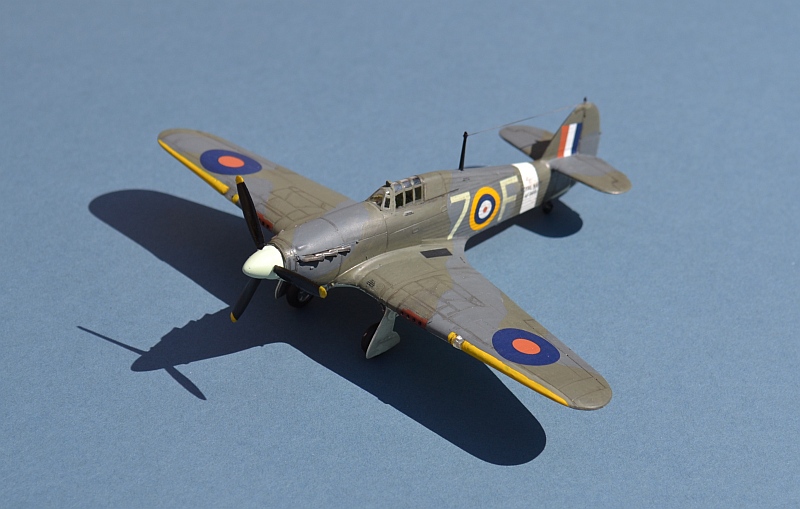
The Sea Hurricane was introduced after Dunkirk/Norway to counter the damage being wrought on convoys by the long range FW200 Condor. Early Sea Hurricanes were basic conversions of RAF Battle of Britain veteran aircraft. Serving at first on Catapult equipped Merchant Ships (as a one way disposable weapon - there were no landing facilities, so the pilot had to ditch alongside), the Sea Hurricane rapidly developed into an effective carrier borne fighter. It formed the backbone (alongside the longer range Fulmar) of the RN's forces in the Mediterranean for Operation Pedestal and later cannon-armed marks equipped Escort Carriers in the Atlantic and Arctic Convoys until the war's end.
INDOMITABLE's squadrons played a major part in the Pedestal actions. Toward the end of the battle, the ship suffered a bomb hit that temporarily put her flight deck out of action; her squadrons simply landed on VICTORIOUS, refuelled and continued the battle.

This is the Revell Mk.IIb Hurricane kit converted into one of 800 Sqn's Pedestal Sea Hurricanes. This seems to be quite a rare issue of the newer Revell Hurricane, using the same main sprue as the IIC kits but with different sprues for the B wing and additional items such as fuel tanks and bombs. This is a modern kit with engraved panel lines and a high standard of buildability and parts fit. The supplied decals are for RAF Hurricanes, but with a few quick modifications to add an arrestor hook and remove the outer pairs of wing guns, it makes a remarkably good Sea Hurricane.

Markings come from the Aeromaster FAA set, depicting this aircraft with 880 Sqn onboard INDOMITABLE at the time of the Madagascar invasion in May 1942 (in which it may not actually have flown). By the time of Operation Pedestal, the same aircraft had been transferred to 800 Sqn on the same carrier, albeit with the newly added yellow wing recognition markings, intended to reduce the risk of blue on blue combat.

The kit builds without any serious problems; the slightly flimsy multi part wings need some careful assembly and the multi-part propeller hub is difficult to clean up. It has a nicely detailed cockpit and undercarriage wells, but the propeller is very poorly represented and my issue had quite a lot of flash throughout. The canopy is very nice but very thin, such that it needs a lot of care when separating from the sprue. I am told that the engine cowling isn't quite big enough for the mark it portrays - making it ideal as an early Sea Hurricane.
More Sea Hurricanes and other WW2 RN Aircraft on my RN Props page
112 Squadron RAF, 239 Wing, Western Desert Air Force, Amriya South LG.91, Egypt, August 1942
Hasegawa, 1/72, OOB
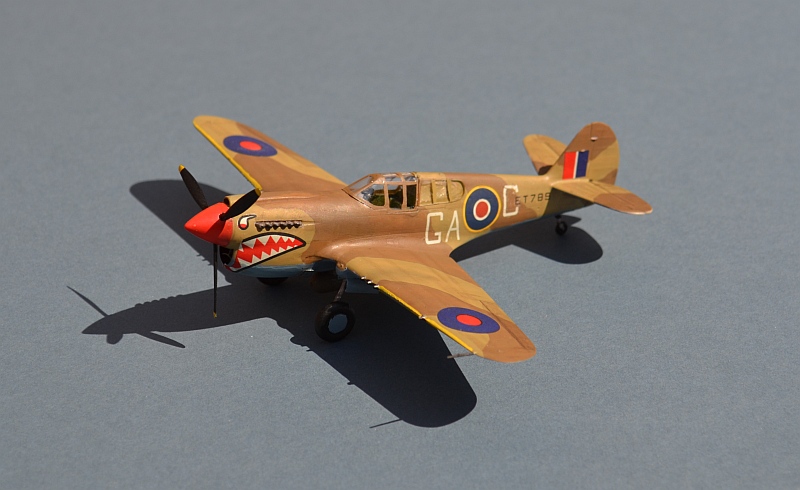
The P-40 Warhawk first flew in 1938. Essentially an in-line Allison V-1710 powered development of the radial P-36 Hawk, initial versions were known as the Tomahawk, with the name Kittyhawk adopted for the RAF P-40D and later variants. The high altitude performance of the P-40 was inadequate for the European Theatre, but the P-40 found its niche with the Commonwealth Desert Air Force (DAF) in North Africa, not least as a ground attack aircraft.
Nearly 14,000 P-40s were built during the war.
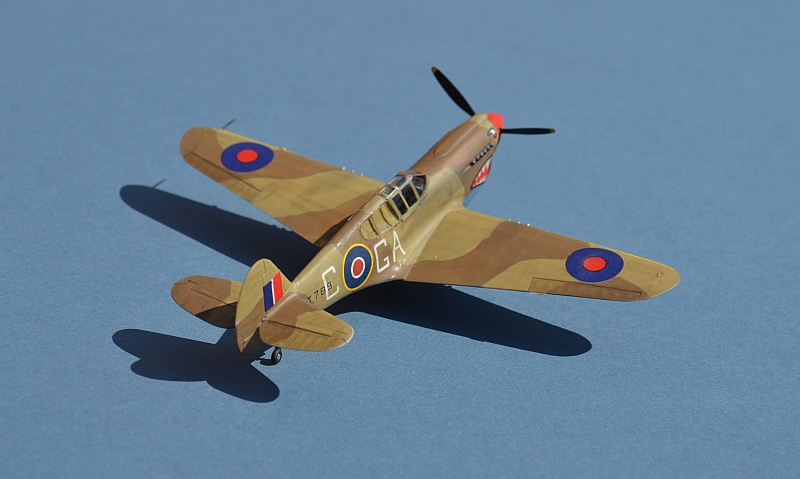
P-40s replaced Western Desert Air Force Hurricanes in early 1941; 112 Sqn RAF was the first unit to use the P-40 in combat and introduced the distinctive shark's mouth marking under the nose, subsequently emulated by many other P-40 units in different theatres. 112 Sqn's aircraft participated in the fighting around El-Alamein and Alam el Halfa in August 1942.
The first ever USAAF combat victory against a Luftwaffe aircraft was claimed in August 1942 by a P-40 based out of Reyjavik in Iceland.
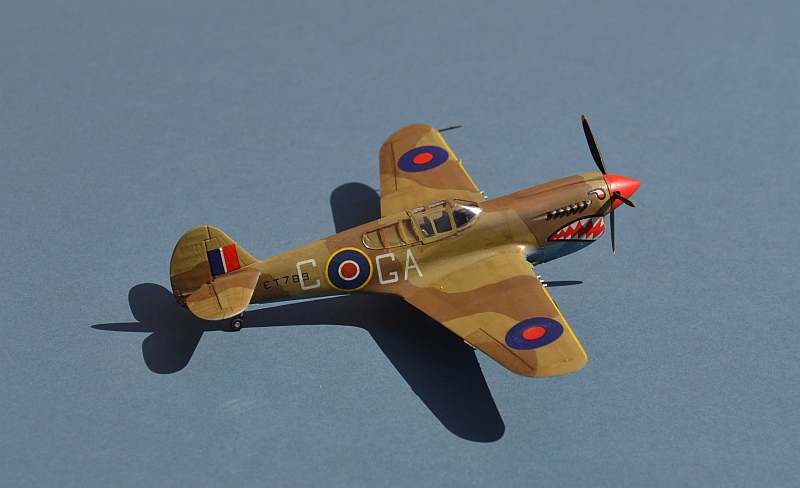
Hasegawa's P40E kit is one of their very first engraved moulds and is a joy to build. Fit is near perfect, detail is restrained but adequate. Decals in my early example are a bit disappointing (the red is too bright and they are slightly out of register - I replaced the fuselage sides and lower wing markings with some Modeldecal items), but otherwise I was very pleased with this kit, especially as I bought it only last month for a very reasonable price (£3) at the Salisbury IPMS show.
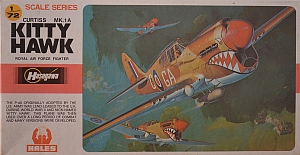
The model depicts a 112 Sqn RAF aircraft based at Amriya South landing ground in Egypt, 1942, and piloted by Sgt. Wallace Daniel Hogg RAF. As with my previous desert aircraft, the Azure Blue lower surfaces are made up from a mixture of Humbrol Azure Blue (too dark) and white.

Earlier this year, an abandoned P-40 was discovered in remarkable condition in the Egyptian desert. It had crashed, possibly due to combat, whilst being ferried to a rear area for repairs. Although it was clear that the pilot, Flight Sergeant Dennis Copping RAF, had survived the crash, as yet his final resting place has not been found. Link to Daily Mail pictures of Flt Sgt Copping's crashed P-40
More RAF aircraft on my Friend & Allies Pages
351 Squadron 155 Grippo. 51 Stormo, August 1942
Frog / HEMA, 1/72.

The elegant and rakish looking Folgore ("Thunderbolt") was developed from the earlier MC200 Saetta by fitting the superb German Daimler Benz DB601 engines (later built under licence by Alfa Romeo). Entering service with the Regia Aeronautica in July 1941, it quickly proved to be an excellent fighter, at least the equal of the Hurricane and as good in the air as the Bf109, but poorly armed with only 2 0.5 inch Breda machine guns. It played a significant role in North Africa and over the skies of Malta, as well as fighting on the Eastern Front against Russia. No less than 139 Folgori took part in Rommel's June 1942 attack on Tobruk and subsequent drive toward el Alamein.
In August 1942, Squadrons of Folgori flying out of Sicily fought against the Pedestal ships, damaging several and clashing with the fleet fighters of the Fleet Air Arm and RAF Malta defenders. After the war, several refurbished aircraft remained in service with the Egyptian Air Force right up until until their replacement by MiG jets in 1951.
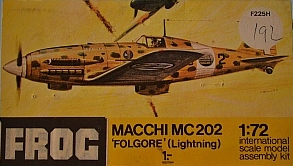
I hesitated slightly before opening this vintage kit, as it's header card has a Frog sticker placed over a HEMA logo which potentially makes it very rare. HEMA are a Dutch department store that likes to "own-brand" items. According to my copy of Lines & Hellstrom, FROG did a deal with them for a very limited number of kits branded as HEMA (2 or 3 types) that didn't include the Folgore. They describe the existence of the HEMA branded Folgore kits as "possible but not confirmed". Well, I can definitely confirm it and I am sure that I have another stashed away somewhere!
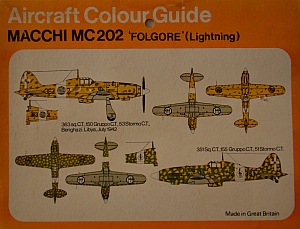
I bought this one second hand from Bath Model Centre a number of years back when they sold off someone's collection, most of which was badly water and mould damaged. Its a typical bagged FROG kit; very simple in detail and complexity but reasonably accurate in shape. There is no cabin, just an armchair-type seat, and you can see through the wheel wells into the cavernous and empty interior. The wings are 3 part, making them slightly fiddly to align, but not as bad as the 3 part (each) tail planes and the undercarriage is somewhat flimsy.

However, as you would expect form an original FROG, fit is good if not excellent and there was no flash. Decals for two quite different colour schemes are offered, one from Libya and one from Sicily, both based on Dick Ward illustrations that can be found easily on the intranet. To fit in with my Operation Pedestal theme this month, I have chosen the more complex Sicily/Malta scheme, which certainly looks striking.

Decals were badly yellowed and didn't respond to an attempt to fade them in the sunlight. They came off the backing paper OK, but were very stiff (one actually cracked and split) so needed lots of Klear and varnish to bed them in and make them conform to the fuselage sides.

As a kit, it may be a little crude, but the end result is quite satisfying and adds another iconic Italian aircraft to my collection!

More Axis aircraft on my Adversaries Pages

From
the rest of my collection; models of other aircraft types that
participated in Operation Pedestal and the Western Desert
(click
the pictures for more details):
Link
to previous month Link
to Next Month
Background
Picture - HM Ships INDOMITABLE and EAGLE seen from the deck of HMS VICTORIOUS
Operation
Pedestal, August 1942
©
Crown Copyright IWM (A 11293)
www.gengriz.co.uk